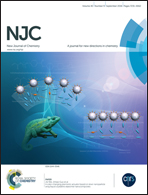Solution-processable bipolar S,S-dioxide-dibenzothiophene chromophores for single-layer organic light-emitting diodes†
Abstract
A series of novel bipolar chromophores consisting of a 4-(9H-carbazole-9-yl)aniline (TCz) moiety as the electron-donating unit and an isomeric meta- or para-linked S,S-dioxide-dibenzothiophene (SO) unit as the electron-withdrawing unit were designed and synthesized. These chromophores exhibited obvious intramolecular charge transfer effects as revealed by photoluminescence spectra. All chromophores exhibited good thermal stabilities. The UV-vis absorption, photoluminescence, and electrochemical properties of these chromophores can be dramatically affected by the isomeric linkage of the SO unit, and the alkylfluorene unit that was incorporated between the SO unit and N-atoms in the 4-(9H-carbazole-9-yl)aniline moiety. The resulting chromophores exhibited moderate electroluminescence properties. The best device performance is attained based on compound M-3, which exhibited a peak luminous efficiency of 5.6 cd A−1 and a luminescence of 16 390 cd m−2 with a turn on voltage of 2.4 V and CIE coordinates of (0.31, 0.58). These results indicated that bipolar architectures can be a promising molecular design strategy for the synthesis of organic semiconductors with efficient light emission.


 Please wait while we load your content...
Please wait while we load your content...